#so many important and overlooked topics intertwined in one game. loved it so much
Text
just finished disco elysium
#GODDDDD OH MY GOD EVERYTHING ABOUT THIS GAME WAS JUST. impeccable#i cant even describe it#i got a really good ending the only downside was that kim wasnt with me cuz he was in the hospital like i really wanted to#finish things off with him :( the fucking dice failed when i tried to warn him about the person#who was about to shoot him. but i still like the choices i made and how everything turned out#also the crytoinsect?? or whatever it is lenas gonna be so happy about it 😭😭😭#so many important and overlooked topics intertwined in one game. loved it so much
5 notes
·
View notes
Text
Character-Driven Backstory
Flashbacks can be tricky. Done poorly, a flashback can kill a story’s momentum, and without proper narrative weight it can leave the reader wondering what was the point of including it in the first place.
I’ve always thought that Robin’s place within the story of One Piece is unique in that her role within the Straw Hat Pirates is paradoxically vital and completely irrelevant at the same time. Pirates don’t need archaeologists in their crews like they need cooks, doctors, and navigators, but to tell the overarching story of One Piece a character like Robin is vital to conveying information to the audience (and more importantly, giving them a reason to care).
Because of Robin’s unique place within the narrative, her backstory is almost automatically the most important to the plot as a whole. To this day there are theories about the nature of the One Piece Universe that are firmly rooted in the tantalizing hints provided between chapters 391 and 398. It’s macro-level storytelling done well, the bread crumbs that have readers spend who knows how many hours theorizing and arguing about a planetarium.
But what I want to talk about today is the importance of the Oharan flashback to Robin herself, how Oda sets up parallels between past and present to emphasize the difference between the two, resulting in one of the most powerful scenes in the entire series.
But first, a picture of babu Robin, because focusing the adorable is the only way I’m gonna get through this without crying
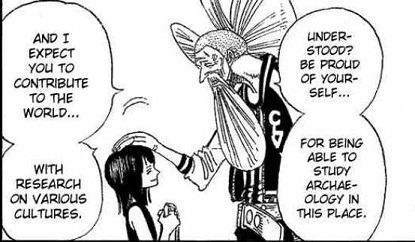
Before we can care about a character’s past we have to care about them in the present. I’ve already written about how important Skypiea is to Robin’s character arc, but to summarize Robin goes from the point of losing her only reason for living/being suicidal to finding people who treat her with respect and one of their own. She doesn’t fully integrate herself into the Straw Hat Pirates, but remains on the outside looking in, her past trauma preventing her from accepting what they have to offer. Still, there’s no doubting that Robin enjoys the Straw Hats and is willing to risk their lives for them.
Then everything when Aokiji attacked

Aokiji’s appearance literally knocks Robin on her ass. The introduction of the admirals really expands the world of One Piece, and is a nice reminder after the successes against Enel and Foxy that there are plenty of threats that are out of the Straw Hat’s weight class.
Luffy isn’t too chuffed about his loss to Aokiji, but Robin and - less important for the purposes of this essay - Usopp are. I’m not going to cover the construction of Water 7′s plot much, although it is fantastic. The thing that I think is often overlooked and what is important for Robin’s development is the fact that she actually betrayed the Straw Hat Pirates.
“But she was trying to save them!” some might argue, but let’s not forget that the Straw Hats didn’t know that. At least not at first. Zoro says so, and if Zoro says it it must be true
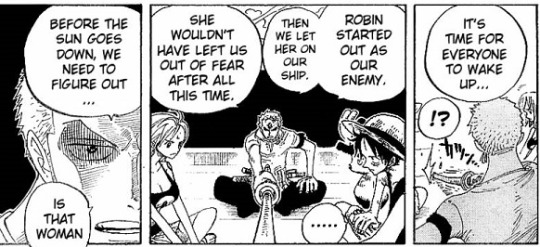
So consider from Robin’s perspective: She, believing herself to be the outsider amongst the Straw Hat Pirates, nevertheless grows attached to them. Aokiji’s attack spooks her into seriously reconsidering her life choices, so much so that when CP9 shows up she immediately agrees to shoot someone she’s never met before in exchange for her new-found friend’s lives. She doesn’t tell them why, doesn’t explain herself, only telling Sanji and Chopper that she’s “a woman of darkness”.
Remember when I said that physical distance is often an indication of emotional separation? Yeah, that’s still the case.
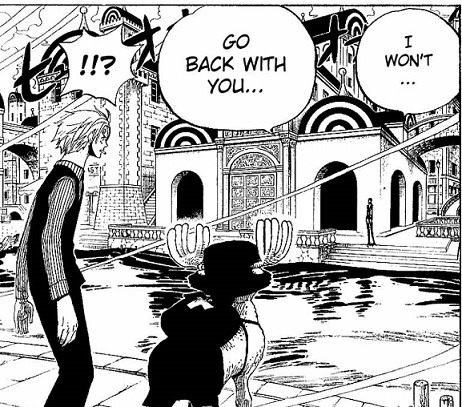
In response, the Straw Hats give Robin the benefit of the doubt. I don’t think this is something she could possibly expect. I mean, the last time she double-crossed someone she ended up with a hook to the chest. During the above scene Sanji and Chopper both tell Robin that they don’t believe the rumors that she targeted Iceburg. This display of the Straw Hat’s true character should have been enough for Robin to trust them, but no. Not only does she confirm that she was one of the assassins, she freaking does it again!
If CP9 had succeeded in the second attempt on Iceburg’s life the Straw Hats would have unjustly been identified as the culprit. Robin believes that they’re strong enough to survive the backlash (and it’s preferable to a Buster Call) but the fact remains Robin betrayed the Straw Hats not once, but twice.
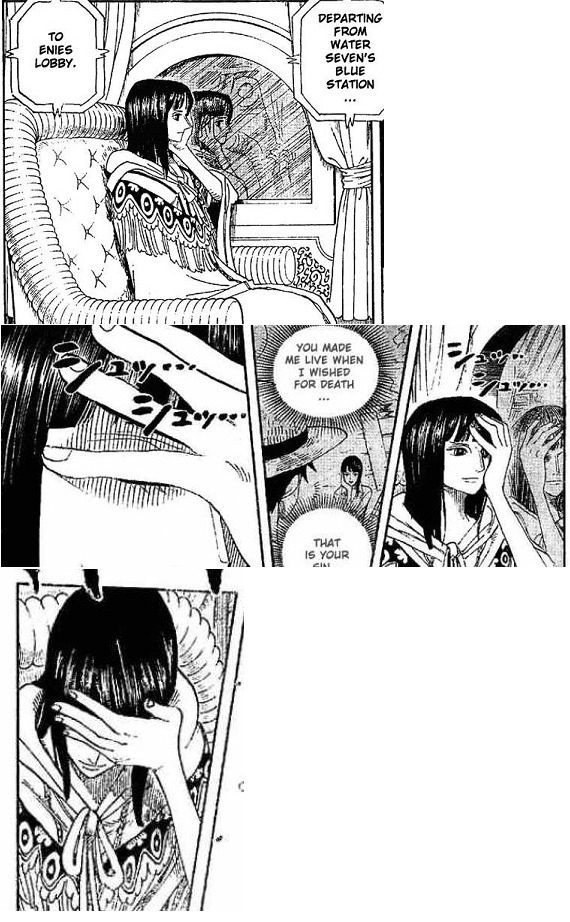
I really like this sequence of panels. I had to cherry pick them over the course of a couple of chapters, but when spliced together they tell us Robin’s mindset at this stage of the game without any dialogue. Robin’s reflection segues neatly into her reflection of the past (I see what you did there, Oda) and also shows some of the duality that defines Robin at this point of the story.
She’s resigned herself to a terrible death, but thinks that she’s saved the only people who have shown her any kindness in twenty years. Robin is smiling, but the fact that she’s also covering her eyes can be read that she is blinding herself to the truth of the situation. Because, honestly, did a world-wise criminal who’s spent two decades seeing the ugliness of life really expect the World Government to let Luffy and co. escape knowing the identity of CP9?
Yeah, she did. And that’s part of the tragedy.
A lot of pain and suffering would never have happened if Robin had just trusted the Straw Hat Pirates from the start. She gets called out about this time and time again, from Iceburg, Franky, and Usopp (side note, I love how Oda connects Franky’s backstory with Robin’s. That’s how you intertwine themes).
In addition to giving us Major Plot Developments, Robin’s backstory tells us why she’s so - for lack of a better term - stuck as a character. If you don’t know Robin’s story it can get really frustrating seeing her reject help again and again and again. I know, because I went to archived chapter discussions on One Piece forums for when these chapters first came out, and some of the attitudes towards Robin were...unflattering, to say the least.
To put it another way, Robin’s backstory gives us context for all her actions, both past and going forward. It does so in a couple of different ways, but the one in particular sticks out.
Parallelism-Linking Past and Present
The cyclical nature of history is something that pops up in One Piece quite often, but Oda usually puts in one or two key differences that keeping things from repeating exactly the same way twice.
In her life Robin experiences two Buster Calls. One ends with the loss of her homeland, her teachers, and her mother. The other ends with the marines suffering complete and utter defeat. The names change, but the circumstances remain the same. Here are some examples.
Spandam
Spandam is the face of the World Government for the Enies Lobby arc. He’s the personification the its self-serving nature, all of the worst qualities of the government seen so far mixed together into a despicable human shitbag. His father is his obvious counterpart for the flashback, a connection that Spandam himself points out
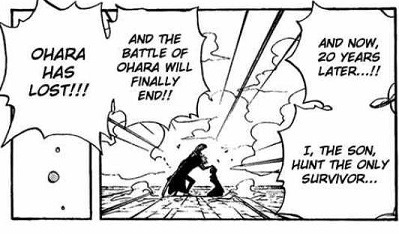
It’s uncomfortable to read the abuse Spandam doles out to Robin over the course of the arc when she’s unable to fight back, but when you get right down to it, is that any different than what Spandine did when he had an 79 million berri bounty put on an eight year old girl?
The difference here is that Spandam is more fanatical and, based on our limited knowledge of Spandine, the bigger narcissist. Seriously, had Spandam spent less time picking at Robin’s wounds until they bled he would have had more than enough time get her through the Gates of Justice. Spandam is clumsy, both in body and how he manages his resources, but I wouldn’t tell him that unless I wanted to spend the rest of my life in Impel Down.
Saul
Saul is the Luffy of Robin’s flashback. Both share the D initial (and have no idea what it means). Both are less concerned with justice than saving their friend. Both teach Robin how to laugh, and in fact have very similar laughs (’shishishi’ vs dreshishishi’).
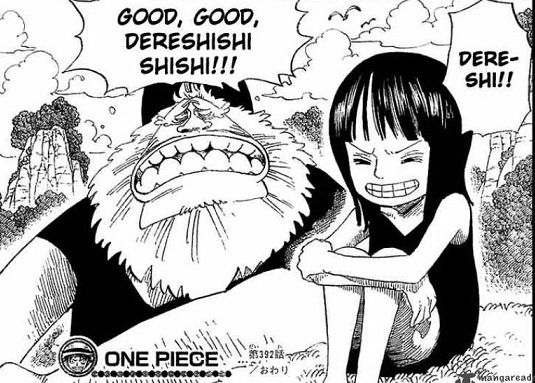
Saul is Robin’s first, and for twenty years only, friend. But when faced with the overwhelming strength of the World Government Saul loses. As much as he wants to, he’s not able to protect Robin when she needs it most. If not for Sakazuki’s rash decision to destroy the evacuation ship Kuzan probably would have killed Robin, and there was nothing Saul could have done to stop him.
As another side note, I want to call attention to this panel
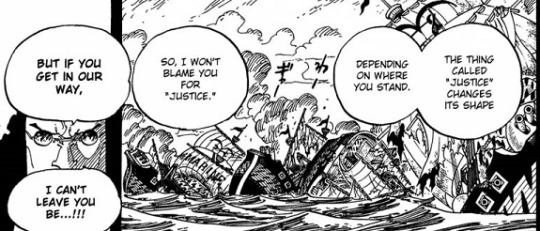
Aokiji is speaking to Saul here while surveying the damage Saul has wrought trying to save Robin. By my count there are seven ships here, and the implication of what Aokiji is saying seems to be that he believes Saul would have participated in the Buster Call were he a marine.
The interesting bit happens on the next page when Sakazuki destroys the evacuation ship, bringing the total of destroyed ships to eight. Now what did that fodder marine say during the Alabasta arc?

The saying is true. Oda never forgets.
Professor Clover and the Archaeologists
Moving back to the topic at hand, the Oharan archaeologists are the only ones besides Saul who accept Robin unconditionally during her childhood years. They parallel the Straw Hat Pirates as a whole

The archaeologists protect Robin and give her sanctuary, but they do so imperfectly. Robin’s treatment from the citizens at large mirror on a much smaller scale the hardship she endures as an adult. Other children bully Robin, sometimes to the point of violence while their parents think that she is a monster. Her own aunt and uncle - the people entrusted to protect and raise her - give her the Cinderella treatment, forcing her to do a great many unpleasant and difficult chores, hit her for trying on her cousin’s clothes, and other disgusting things like berate her for eating too much food because she’s a freeloader.
We’re not told how old Robin is when she goes to the Tree of Knowledge for the first time, but she’s pretty damn little and is clearly terrified that Professor Clover might be angry at her for looking at a book in a library

But while the archaeologists allow her to study history, they forbid Robin from following her dream of finding out the truth of the Void Century. Their reasoning is justified, but it’s the exact opposite of Luffy and the rest of the Straw Hat Pirates.
Olvia
If the archaeologists can be compared to the Straw Hats, then it stands to reason that Oliva is a stand in for Robin herself. They look virtually identical, both share the same dream, and are literally related. They share everything from birthdays to voice actresses, with one key difference: Robin is willing to abandon her dream for the sake of those she loves.
I’ll let the manga do the comparison for me. Here’s Olvia’s choice
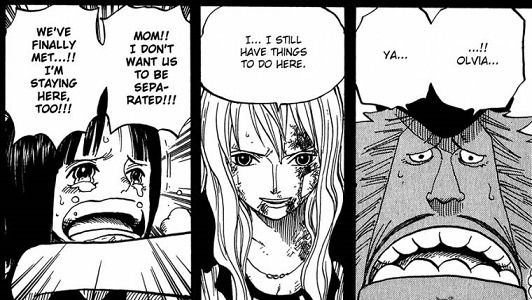
versus Robin’s
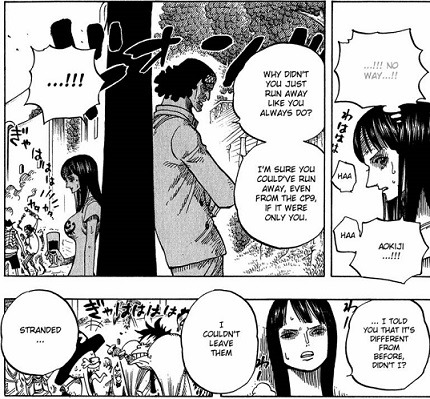
Would Olvia lived had she tried to flee with Robin? There’s no way of knowing. Would Robin have had an easier time of surviving for twenty years with another adult with her best interests at heart watching over her? Yeah, probably.
Now his isn’t the only time Oda has his characters make a “dream or crew” decision. Zoro’s sacrifice on Thriller Bark and Sanji’s decision to get married are more memorable, but they were hardly the first.
Olvia’s decision to save instead of her daughter still baffles me, and is one of the few things about Robin’s flashback that leaves a bad taste in my mouth. I don’t think Oda was wrong for writing Olvia this way, but she’s certainly not going to win Mom of the Year anytime soon. She does, however, give Robin one very important command, and that is to live.

Does this panel look familiar? It should.
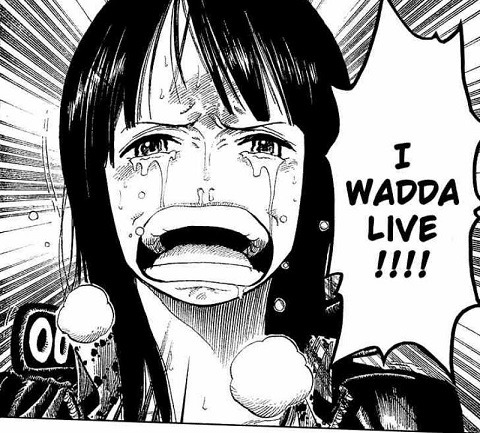
It’s only when we’re given proper context that Oda removes any ambiguity and has Robin say for herself why she wants to die. It’s not what has happened that frightens her, but the potential of what might happen. This isn’t Robin’s first song and dance, she has seen this all happen before, and can’t stand the pain of losing everyone she loves for a second time. Moreover, because of being forced to spend twenty years with less than stellar characters, she’s utterly convinced that even if the Straw Hats survive the wrath of the World Government they will come to hate her, because that’s what everyone else has done for the past twenty years. We see the exact moment when Robin stops believing in Saul’s laugh, and while we don’t know how old she is, I’d hazard it can’t be much more than ten.
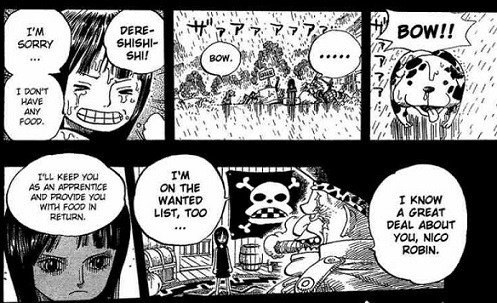
The Result
The famous “I want to live” scene the first time we see Robin cry, flashback notwithstanding, since the end of the Alabasta arc, and the circumstances couldn’t be more different. Her character has arched. Robin finally allows herself to be emotionally vulnerable, risking enormous mental anguish if she happens to be wrong and the Straw Hats come to see her as a burden.
Because while there are many parallels to the past, Oda uses them to highlight the differences of the present. The scene starts with a literal chasm between the Robin and the Straw Hats

and it ends with the gap between them bridged, and that bridge is Luffy (also literally with a little help from Rocket Man, lol). By unflinchingly declaring war on the World Government and winning Luffy does something no one else could have done.
By constructing Robin’s backstory the way he did, Oda not only justifies Robin’s previous inability to trust the Straw Hats and exposes the true root of her hopelessness. He weaves the core message from Franky’s backstory, that simply existing cannot be a crime, into Robin’s themes of acceptance, trust, and friendship. In doing so he bolsters the greater message of One Piece as a whole.
These are hardly unique tropes within shonen manga, or any other medium for that matter, but when done well the end result can be incredibly powerful. I’ve been reading One Piece for more than ten years now, and Robin’s backstory and the immediate aftermath still affect me in a way that’s difficult to put into words.
Damn it, I’m getting teary eyed just thinking about it. Here’s more of Robin being cute to counter all the angst.
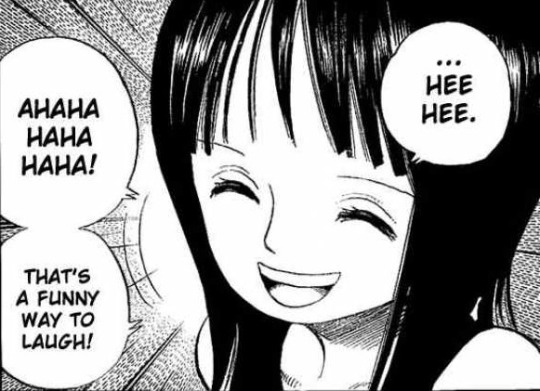
(thanks all for reading. I think I’ve said about all I want to say about Robin’s character arc. I might do a post on Chopper next, but I’m also open to suggestions)
#One Piece#Robin#Nico Robin#Character analysis#Manga#writing#analysis#flashback#creative-type analyzes
169 notes
·
View notes
Text
Historical Fiction as a Mirror to the Present: Elise Hooper’s Fast Girls
You may have noticed that over the past year you have heard the name Elise Hooper on this blog or in the store. There’s a reason for that.
Elise Hooper is a writer living in West Seattle whose book The Other Alcott was championed by our booksellers. As we worked with Elise on events, we realized that we also wanted to champion her as a person. She is funny, kind, and always game to support and promote local bookstores. On a personal note, Elise was one of the first authors I interviewed over 2019 for her previous release Learning to See. Her kindness and openness allowed me to ask to edit part of her newest release Fast Girls for my editing certificate. She also has joined our knitting book club when she is able and has been a great friend of the store.

Months ago, Elise and I got into the nitty gritty of Fast Girls, focusing on the way she crafted and presented the stories of the women in her book. Elise has a never-ending well of passion for overlooked and critical figures in history, and it was lovely to see her thoughts and reflections on her work, especially as she has had more distance from researching and writing it. Her most prominent and important reflections highlighted how the political and social climate of 1936 held a mirror up to today. In writing, she found she was saddened by how little change had occurred and how much more there is to go. Using primary sources, she was able to paint a picture of that world to help readers see that beyond the unfamiliar slang and outdated technology, we live in very similar worlds.
Fast Girls opens on the 1928 Olympics, where Betty Robinson wins a medal as one of the first women to compete in track and field in the Olympics. Helen Stephens, an awkward and insecure teen in Missouri, is inspired by Betty’s success and determined to find a place of her own. Louise Stokes, from Massachusetts, looks to Betty’s win as inspiration to surpass the obstacles she has had to confront as one of the only black women in her town to a successful athletics career. The narratives intertwine and follow the tragedies and successes that bring all three of these incredible athletes to the 1936 Olympics in Nazi Germany.

What I enjoyed most about the book is that Elise does not sugarcoat the struggles of these women. While it would have been easy to alter the timelines or events of these women's lives for a better reading experience, she knew she had to keep the story as accurate as possible. For example, Louise Stokes never actually gets to race at any Olympics. While brought to the games twice, she is never given a chance to go out on the field and is pulled from rosters once at the stadiums. The blatant racism doesn’t give Louise Stokes a successful ending like Helen Stephens seems to receive. Elise recalled having a conversation with her editor about how to structure the ending in a satisfactory way for the reader, “She and I had a call I remember, and I said, ‘So, how do we deal with this real tension at the ending?’ And she was so funny, she goes, ‘I don’t know but that’s your job, so get at it and figure it out.’... No one had a magic solution for me. But at the same time, that’s the whole point. That’s life. So while it felt so frustrating to describe the outcome of the races in 1932 and 1936, [they are] really important. It takes several decades for [the racial bias] to be somewhat amended… I end on this note, on this big victory for the country, but there is a huge personal toll that comes at its expense. I just… did my best to be present for all three of my characters.”
And presence is asked of the reader too. While many books about women, written by women, are denoted “chicklit,” Elise is firmly pointing out how women’s issues are the country’s issues. Much of Elise and my conversation focused on how she ties the women featured in her book to the women that were going to be competing in the 2020 Olympics. “A big piece of news in Rio was this growing awareness of how differently we talked about women athletes from men athletes.” She went on to describe multiple instances where women were asked questions about their clothes and makeup or maligned for talking about their body in concrete ways (like having a period while competing). To give context to the story, she researched and wrote many articles in Fast Girls in the style of the way many newspapers talked about women in the 1930s. She found they reflected our obsession with women, motherhood, the state of their bodies, and their relationships to their coaches. “[Articles were about] these women who are coached by their husbands. And that’s always a note that commentators [today] make. When this woman has had this amazing moment, won a medal or something big, and the camera immediately pans to the husband. And suddenly he’s getting the credit for his athlete’s win,” Elise said. Men, on the other hand, tend to be asked about far more substantial and relevant topics and still have more events to compete in than women.

And this bigotry, both subtle and obvious, is intersectional in its targets. Whether talking about members of the LGBTQ+ community, particularly intersex athletes, or people of color, the American Olympics teams and press haven’t done enough work in promoting diversity and actually representing America in their athletes. I then asked her how learning about the way people of color were treated in the 1936 Olympics affected the way she sees the Olympics as they are today:
“That was a really eye-opening part of this book. I knew there was a tension between the US and Germany over various policies, but I hadn’t realized how limited a view someone like Avery Brundage who was actually in charge of the Olympics had. He was not at all subtle about his own feelings in… having no objections about not letting Jews compete in the Olympics… I think the Olympics offer a really interesting mirror for society in the time between 1936 and today. There are so many interesting Olympic stories about American, and of course international, athletes and the civil rights obstacles they were having to overcome to compete. The fact that so many of the men that returned from the Berlin Olympics couldn’t race in college races at home, even though they had Olympic medals, because of the color of their skin and the laws of the Jim Crow South is an amazing thing. I have a feeling a lot of people don’t fully realize how limited opportunities were for these athletes, even when they come home having accomplished really impressive feats of athleticism. And that doesn’t end in ‘36. That’s for the next several decades and beyond… Putting my magnifying glass up to these Olympics has been so eye-opening in so many ways about race, about gender, and about sexuality.”
Elise’s new book puts narrative and context on a time period bubbling with change and devastation. While the stories told contain moments of joy and success, the book is marked by the grief and losses of these women. What they overcame and how they persevered or were unable to are critical points of civil rights history. “Not as much as we would like [has changed],” Elise commented at the end of our interview. And hopefully works like hers, promoting stories previously unacknowledged, can inspire us to look critically at our world today in athletics and beyond. Though our stop on her social distanced and virtual tour isn’t as we planned or dreamed, we hope you come by and share your support of this new book that shines light on women that have otherwise been ignored throughout history.
Elise will be joining us for an event celebrating her book release later this month:
Elise Hooper, Author of Fast Girls, with Tracy Rees, Author of Amy Snow on July 26th at 11:00am PST. Register here!
— Kelleen
#island books#elise hooper#fast girls#1936 olympics#1928 olympics#learning to see#kelleen cummings#store journal#sports#racism in sports#sexism in sports#homophobia in sports
0 notes